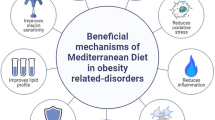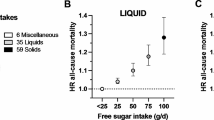Abstract
Purpose
Fruit and vegetable (FV) consumption and salt intake are known dietary influences on blood pressure (BP) in adults, but data on their long-term relevance during growth for later BP are rare. We aimed to examine the independent and concomitant influences of adolescent FV and salt intakes on BP in young adulthood.
Methods
In total, 206 participants (108 males) provided a plausible BP measurement in young adulthood (18–25 years) as well as three repeated 3-day weighed dietary records, 24-h urine samples and BP measurements during adolescence (11–16 years). FV intake was assessed based on dietary records and its urinary biomarkers such as potassium, oxalate and hippuric acid. Urinary sodium chloride (NaCl) was used to estimate salt intake. Prospective associations of adolescent FV and salt intake with adult BP were examined in sex-stratified linear regression models.
Results
In multivariable models, a 100 g higher FV intake during adolescence was prospectively related to 0.9 mmHg lower systolic BP in young adult females (P = 0.02), but not in males (P = 0.8). Biomarkers supported the findings for FV regarding systolic BP. Concurrently, a 1 g higher salt intake was related to 1.7 mmHg higher systolic BP in young men only (P = 0.01). For diastolic BP, results were inconsistent.
Conclusions
Our findings suggest that in adolescent healthy girls, a higher FV intake may be more relevant for BP than a reduced salt intake and the opposite appears to apply for boys. The physiological implications of the observed sex-specific diet–BP relationships need deeper examination.

Similar content being viewed by others
References
WHO (2009) Global health risks: mortality and burden of disease attributable to selected major risks. World Health Organization (WHO), Geneva, pp 1–62
Gray L, Lee IM, Sesso HD, Batty GD (2011) Blood pressure in early adulthood, hypertension in middle age, and future cardiovascular disease mortality: HAHS (Harvard Alumni Health Study). J Am Coll Cardiol 58:2396–2403
Myers VH, Champagne CM (2007) Nutritional effects on blood pressure. Curr Opin Lipidol 18:20–24
He FJ, Li J, Macgregor GA (2013) Effect of longer term modest salt reduction on blood pressure: Cochrane systematic review and meta-analysis of randomised trials. BMJ 346:f1325
Boeing H, Bechthold A, Bub A, Ellinger S, Haller D, Kroke A et al (2012) Critical review: vegetables and fruit in the prevention of chronic diseases. Eur J Nutr 51:637–663
Moore LL, Singer MR, Bradlee ML, Djousse L, Proctor MH, Cupples LA et al (2005) Intake of fruits, vegetables, and dairy products in early childhood and subsequent blood pressure change. Epidemiology 16:4–11
Moore LL, Bradlee ML, Singer MR, Qureshi MM, Buendia JR, Daniels SR (2012) Dietary approaches to stop hypertension (DASH) eating pattern and risk of elevated blood pressure in adolescent girls. Br J Nutr 108:1678–1685
van de Laar RJ, Stehouwer CD, van Bussel BC, te Velde SJ, Prins MH, Twisk JW et al (2012) Lower lifetime dietary fiber intake is associated with carotid artery stiffness: the Amsterdam Growth and Health Longitudinal Study. Am J Clin Nutr 96:14–23
Jaaskelainen P, Magnussen CG, Pahkala K, Mikkila V, Kahonen M, Sabin MA et al (2012) Childhood nutrition in predicting metabolic syndrome in adults: the cardiovascular risk in Young Finns Study. Diabetes Care 35:1937–1943
Steffen LM, Kroenke CH, Yu X, Pereira MA, Slattery ML, Van Horn L et al (2005) Associations of plant food, dairy product, and meat intakes with 15-years incidence of elevated blood pressure in young black and white adults: the Coronary Artery Risk Development in Young Adults (CARDIA) Study. Am J Clin Nutr 82:1169–1177; quiz 1363–1164
He FJ, MacGregor GA (2006) Importance of salt in determining blood pressure in children: meta-analysis of controlled trials. Hypertension 48:861–869
Brion MJ, Ness AR, Davey Smith G, Emmett P, Rogers I, Whincup P et al (2008) Sodium intake in infancy and blood pressure at 7 years: findings from the Avon Longitudinal Study of Parents and Children. Eur J Clin Nutr 62:1162–1169
Geleijnse JM, Grobbee DE, Hofman A (1990) Sodium and potassium intake and blood pressure change in childhood. BMJ 300:899–902
Wills AK, Lawlor DA, Matthews FE, Sayer AA, Bakra E, Ben-Shlomo Y et al (2011) Life course trajectories of systolic blood pressure using longitudinal data from eight UK cohorts. PLoS Med 8:e1000440
Mensink GB, Kleiser C, Richter A (2007) Lebensmittelverzehr bei Kindern und Jugendlichen in Deutschland. Ergebnisse des Kinder- und Jugendgesundheitssurveys (KiGGS). Bundesgesundheitsblatt Gesundheitsforschung Gesundheitsschutz 50:609–623
Remer T, Neubert A, Maser-Gluth C (2002) Anthropometry-based reference values for 24-h urinary creatinine excretion during growth and their use in endocrine and nutritional research. Am J Clin Nutr 75:561–569
Sichert-Hellert W, Kersting M, Chada C, Schäfer K, Kroke A (2007) German food composition database for dietary evaluations in children and adolescents. J Food Compos Anal 20:63–70
Smith-Warner SA, Elmer PJ, Tharp TM, Fosdick L, Randall B, Gross M et al (2000) Increasing vegetable and fruit intake: randomized intervention and monitoring in an at-risk population. Cancer Epidemiol Biomark Prev 9:307–317
Meschi T, Maggiore U, Fiaccadori E, Schianchi T, Bosi S, Adorni G et al (2004) The effect of fruits and vegetables on urinary stone risk factors. Kidney Int 66:2402–2410
Krupp D, Doberstein N, Shi L, Remer T (2012) Hippuric acid in 24-hour urine collections is a potential biomarker for fruit and vegetable consumption in healthy children and adolescents. J Nutr 142:1314–1320
Frank T, Netzel G, Kammerer DR, Carle R, Kler A, Kriesl E et al (2012) Consumption of Hibiscus sabdariffa L. aqueous extract and its impact on systemic antioxidant potential in healthy subjects. J Sci Food Agric 92:2207–2218
Toromanovic J, Kovac-Besovic E, Sapcanin A, Tahirovic I, Rimpapa Z, Kroyer G et al (2008) Urinary hippuric acid after ingestion of edible fruits. Bosn J Basic Med Sci 8:38–43
Tomokuni K, Ogata M (1972) Direct colorimetric determination of hippuric acid in urine. Clin Chem 18:349–351
Yang W, Gu D, Chen J, Jaquish CE, Rao DC, Wu X et al (2008) Agreement of blood pressure measurements between random-zero and standard mercury sphygmomanometers. Am J Med Sci 336:373–378
Neuhauser H, Schienkiewitz A, Schaffrath Rosario A, Dortschy R, Kurth B-M (2011) Referenzperzentile für anthropometrische Maßzahlen und Blutdruck aus der Studie zur Gesundheit von Kindern und Jugendlichen in Deutschland (KiGGS) 2003–2006. Robert Koch-Institut, Berlin, pp 100–113
He FJ, Marrero NM, Macgregor GA (2008) Salt and blood pressure in children and adolescents. J Hum Hypertens 22:4–11
He J, Gu D, Chen J, Jaquish CE, Rao DC, Hixson JE et al (2009) Gender difference in blood pressure responses to dietary sodium intervention in the GenSalt study. J Hypertens 27:48–54
Miura K, Okuda N, Turin TC, Takashima N, Nakagawa H, Nakamura K et al (2010) Dietary salt intake and blood pressure in a representative Japanese population: baseline analyses of NIPPON DATA80. J Epidemiol 20(Suppl 3):S524–530
Pechere-Bertschi A, Burnier M (2004) Female sex hormones, salt, and blood pressure regulation. Am J Hypertens 17:994–1001
Nakamura K, Nagata C, Oba S, Takatsuka N, Shimizu H (2008) Fruit and vegetable intake and mortality from cardiovascular disease are inversely associated in Japanese women but not in men. J Nutr 138:1129–1134
Cassidy A, O’Reilly EJ, Kay C, Sampson L, Franz M, Forman JP et al (2011) Habitual intake of flavonoid subclasses and incident hypertension in adults. Am J Clin Nutr 93:338–347
Haddy FJ, Vanhoutte PM, Feletou M (2006) Role of potassium in regulating blood flow and blood pressure. Am J Physiol Regul Integr Comp Physiol 290:R546–552
Murakami K, Sasaki S, Takahashi Y, Uenishi K (2008) Association between dietary acid–base load and cardiometabolic risk factors in young Japanese women. Br J Nutr 100:642–651
Zhang L, Curhan GC, Forman JP (2009) Diet-dependent net acid load and risk of incident hypertension in United States women. Hypertension 54:751–755
Krupp D, Shi L, Maser-Gluth C, Pietzarka M, Remer T (2013) 11beta Hydroxysteroid dehydrogenase type 2 and dietary acid load are independently associated with blood pressure in healthy children and adolescents. Am J Clin Nutr 97:612–620
Acknowledgments
The DONALD study is funded by the Ministry of Science and Research of North Rhine Westphalia, Germany. This work was partially supported by the Federal Ministry of Food, Agriculture and Consumer Protection (BMELV) through the Federal Agency for Agriculture and Food (BLE), Grant No. 2811HS007.
Conflict of interest
The authors declare that they have no conflict of interest.
Author information
Authors and Affiliations
Corresponding author
Rights and permissions
About this article
Cite this article
Krupp, D., Shi, L., Egert, S. et al. Prospective relevance of fruit and vegetable consumption and salt intake during adolescence for blood pressure in young adulthood. Eur J Nutr 54, 1269–1279 (2015). https://doi.org/10.1007/s00394-014-0804-y
Received:
Accepted:
Published:
Issue Date:
DOI: https://doi.org/10.1007/s00394-014-0804-y




